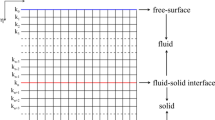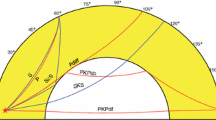Abstract
2.5-D modeling and inversion techniques are much closer to reality than the simple and traditional 2-D seismic wave modeling and inversion. The sensitivity kernels required in full waveform seismic tomographic inversion are the Fréchet derivatives of the displacement vector with respect to the independent anisotropic model parameters of the subsurface. They give the sensitivity of the seismograms to changes in the model parameters. This paper applies two methods, called ‘the perturbation method’ and ‘the matrix method’, to derive the sensitivity kernels for 2.5-D seismic waveform inversion. We show that the two methods yield the same explicit expressions for the Fréchet derivatives using a constant-block model parameterization, and are available for both the line-source (2-D) and the point-source (2.5-D) cases. The method involves two Green’s function vectors and their gradients, as well as the derivatives of the elastic modulus tensor with respect to the independent model parameters. The two Green’s function vectors are the responses of the displacement vector to the two directed unit vectors located at the source and geophone positions, respectively; they can be generally obtained by numerical methods. The gradients of the Green’s function vectors may be approximated in the same manner as the differential computations in the forward modeling. The derivatives of the elastic modulus tensor with respect to the independent model parameters can be obtained analytically, dependent on the class of medium anisotropy. Explicit expressions are given for two special cases—isotropic and tilted transversely isotropic (TTI) media. Numerical examples are given for the latter case, which involves five independent elastic moduli (or Thomsen parameters) plus one angle defining the symmetry axis.






Similar content being viewed by others
References
Ali, H. B. H., Operto, S. and Virieux, J. (2008), Velocity model building by 3D frequency-domain full-waveform inversion of wide-aperture seismic data, Geophysics 73, VE101–VE117.
Carey, G. F. and Oden, J. T. (1983), Finite Elements: A Second Course Volume II, Prentice Hall Inc, Englewood Cliffs.
Furumura, T., and Takenaka, H., (1996), 2.5-D modelling of elastic waves using the pseudo-spectral metod, Geophysical Journal International 124, 820–832.
Gan, H., Ludwig, R. and Levin, P. L., (1994), Nonlinear diffraction inverse scattering for multiple scatterers in inhomogeneous acoustic background media, Journal of the Acoustical Society of America 97, 764–776.
Gelius, L. J., (1995), Generalized acoustic diffraction tomography, Geophysical Prospecting 43, 3–29.
Gélls, C., Virieux, J., and Grandjean, G., (2007), Two-dimensional elastic full waveform inversion using Born and Rytov formulations in the frequency domain, Geophysical Journal International 168, 605–633.
Greenhalgh, S. A. and Zhou B., (2003), Surface seismic imaging with multi-frequency full-waveform inversion, Exploration Geophysics 34, 217–224.
Greenhalgh, S. A., Zhou B., Green, A., (2006), Solutions, algorithms and inter-relations for local minimization search geophysical inversion, J. Geophys. Eng. 3, 101–113.
Menke, W., (1989), Geophysical Data Analysis: Discrete Inverse Theory, Academic Press Inc
Novais, A., and Santos, I. T., (2005), 2.5D finite difference solution of the acoustic wave equation, Geophysical Prospecting 53, 523–531.
Mora, P., (1987), Nonlinear two-dimensional elastic inversion of multioffset seismic data, Geophysics 52, 1211–1228.
Pratt, R. G., (1999), Seismic waveform inversion in the frequency-domain, Part 1: Theory and verification in a physical scale model, Geophysics 64, 902–914.
Sinclair, C., Greenhalgh, S. A., and Zhou B., (2007), 2.5D modelling of elastic waves in transversely isotropic media using the spectral element method, Exploration Geophysics 38, 225–234.
Smith,N.C., and Vozoff, K., (1984), Two-dimensional DC resistivity inversion for dipole-dipole data, IEEE Transactions on Geoscience and Remote Sensing GE-22, 21–28.
Song, Z. M., and Williamson, P. R., (1995), Frequency-domain acoustic wave modelling and inversion of crosshole data: Part I — 2.5D modelling method, Geophysics 60, 784–795.
Tape, C., Liu, Q., and Tromp, J., (2007), Finite-frequency tomography using adjoint methods — Methodology and examples using membrane surface waves: Geophysical Journal International 168, 1105–1129.
Tarantola, A, (1984), The seismic reflection inverse problem, in Inverse Problems of Acoustic and Elastic Waves, Santosa, F., Pao, Y.H., Symes, W and Holland, Ch., Eds: SIAM, Philadelphia
Thomsen, L., (1986). Weak elastic anisotropy, Geophysics 51, 1954–1966.
Tromp, J., Tape, C., and Q. Liu, Q., (2005), Seismic tomography, adjoint methods, time reversal and banana-doughnut kernels, Geophysical Journal International 160, 195–216.
Williamson, P. R., and Pratt, R. G., (1995), A critical review of the acoustic wave modelling procedure in 2.5 dimensions, Geophysics 60, 591–595
Wu, R.-S., and Toksoz, M. N., (1987), Diffraction tomography and multisource holography applied to seismic imaging, Geophysics 52, 11–25.
Zhou, B. and Greenhalgh, S.A., (1998), Crosshole acoustic velocity imaging with the full-waveform spectral data: 2.5-D numerical simulations, Exploration Geophysics 29, 680–684.
Zhou, B. and Greenhalgh, S.A., (1999), Explicit expressions and numerical computation of the Fréchet and second derivatives in 2.5D Helmholtz equation inversion, Geophysical Prospecting, 47, 443–468.
Zhou, B. and Greenhalgh, S.A., (2003), Crosshole seismic inversion with normalized full-waveform amplitude data, Geophysics 68, 1320–1330.
Zhou, B. and Greenhalgh, S.A., (2006), An adaptive wavenumber sampling strategy for 2.5D seismic wave modelling in the frequency-domain, Pure and Applied Geophysics 163, 1399–1416.
Zhou, B. and Greenhalgh, S.A., (2009a), On the computation of the Fréchet derivatives for seismic waveform inversion in 3D general anisotropic, heterogeneous media, Geophysics 74, WB153–WB163.
Zhou, B., Greenhalgh, M., Greenhalgh, S.A., (2009b), 2.5-D/3-D resistivity modelling in anisotropic media using Gaussian quadrature grids, Geophysical Journal International, 176, 63–80.
Acknowledgments
This work was supported by the Australian Research Council and the Swiss National Science Foundation. The authors thank the staff of the Helpdesk at eResearch SA who provided assistance in using the advanced super-computing facilities for this project. Also, we greatly appreciated the comments of two anonymous reviewers, which have improved the paper.
Author information
Authors and Affiliations
Corresponding author
Appendices
Appendix A: Self-adjoint and Anti-self-adjoint Operators
Substituting Eq. 2 for Eq. 6, one has
Here, Stoke’s theorem, the natural boundary condition v|Γ→∞ = u|Γ→∞ = 0 and the symmetric property of the elastic moduli c 2jk2 = c 2kj2 are applied to Eq. 42, where Γ stands for the boundary of the domain Ω. Equation 42 shows the operator D 1(m) is self-adjoint.
Substituting Eq. 2 into Eq. 7, we obtain
Here, we once again apply Stoke’s theorem, the natural boundary condition and the symmetric property of c 2kji = c ijk2 to Eq. 43, which shows the operator D 2(m) to be an anti-self-adjoint one.
Appendix B: Derivatives of the Elastic Modulus Tensor
Applying Eq. 33, we obtain the derivatives of the thirteen non-zero elastic moduli (c 11, c 12, c 13, c 15, c 22, c 23, c 25, c 33, c 35, c 44, c 45, c 55, c 66) with respect to the five independent parameters \( (c_{{1^{\prime}1^{\prime}}} ,\;c_{{1^{\prime}3^{\prime}}} ,\;c_{{3^{\prime}3^{\prime}}} ,\;c_{{4^{\prime}4^{\prime}}} ,\;c_{{6^{\prime}6^{\prime}}} ) \) and the dip angle of the axis of symmetry θ 0:
According to the relationship between the elastic moduli \( \{ c_{{1^{\prime}1^{\prime}}} ,c_{{1^{\prime}3^{\prime}}} ,c_{{3^{\prime}3^{\prime}}} ,c_{{4^{\prime}4^{\prime}}} ,c_{{6^{\prime}6^{\prime}}} \} \) and the Thomsen parameters {ρ, α 0, β 0, ɛ, δ *, γ}(Thomsen, 1986):
we have
Rights and permissions
About this article
Cite this article
Zhou, B., Greenhalgh, S.A. Computing the Sensitivity Kernels for 2.5-D Seismic Waveform Inversion in Heterogeneous, Anisotropic Media. Pure Appl. Geophys. 168, 1729–1748 (2011). https://doi.org/10.1007/s00024-010-0191-0
Received:
Revised:
Accepted:
Published:
Issue Date:
DOI: https://doi.org/10.1007/s00024-010-0191-0




